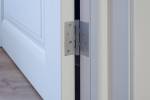Green living wise for environment, economy
I'm a long-term thinker. I like things like the Clock of the Long Now, a project that seeks to reverse the pathologically short attention span of modern civilization. When you think about it, what's the sense in constantly maximizing next quarter's profits if, in the not-so-long run, we overlook or ignore the ill effects on our only home, this exquisitely beautiful blue-green globe?
On the other hand, we're currently stuck with an economic system that demands almost constant attention. Doing anything less can result in suboptimal results, like going hungry. The trick is to find ways to invest our dollars that can satisfy our need for short-term economic benefits while also enhancing the long-term viability of our culture.
Green living is, by its very nature, economically prudent and environmentally responsible. The best green investments are also the most affordable. They provide huge returns and are available to everyone. I'm talking about compact fluorescent lamps or CFLs.
Back in 1879, Thomas Edison invented a device that got so hot it glowed brightly -- the incandescent light bulb. While it revolutionized society, it also used a lot of power. In fact, a traditional incandescent lamp uses about 90 percent of its energy to produce heat. The other 10 percent produces the actual light we want. If an employee was that inefficient, he or she would not be able to keep his or her job very long.
By contrast, CFLs are much more efficient at producing light, so they run cooler and use a lot less energy. In addition, they last about 10 times longer than standard incandescent light bulbs. Hmmm, sounds like it might be time to fire those old bulbs and hire some new CFLs.
Let's look at the short-term economics a bit closer, just to make sure. Assume you replace one 60-watt light bulb ($.49) that is used an average of four hours per day with an equivalent 14-watt CFL ($1.72). After factoring in the purchase cost, useful life (1,500 vs. 10,000 hours) and energy savings (more than $8 per year), the payback is less than two months with an annual return on investment of more than 600 percent. That one bulb will save more than $50 in energy over its lifetime. A detailed Excel spreadsheet with all the calculations can be downloaded from the Green Living columns section of my Web site (www.greendream.biz).
Since CFLs run so much cooler, your air conditioner will not work as hard, saving even more. Switching most of your lights to CFLs, especially the ones you use a lot, can have a significant and immediate impact on your power bill.
With so many reasons to change to CFLs, you might wonder if there is a down side. There are a few. First, since they last so long, you might forget how to change a light bulb. I think we can all deal with that problem.
If you use a dimmer, make sure you get CFLs that are designed for that purpose. They also come in many shapes and sizes and can be used in nightlights, recessed ceiling fixtures, porch lights, reading lamps, bathroom fixtures, etc., so purchase what best suits the application.
Since they can sometimes vary slightly in color temperature, you might want to try just one or two first. If you like what you see, buy more of the exact same make and model. Otherwise, return them and try a different brand.
Lastly, CFLs must be used responsibly. Like all fluorescent lamps, they have a small amount of mercury inside the sealed glass. Mercury is toxic and must stay contained. Don't use CFLs in areas where they are likely to be knocked down and broken, like in a kid's playroom for example. The amount of mercury in a CFL is very small, typically from one to five milligrams, hundreds of times less than that of an old-style thermometer. A broken lamp is not cause for serious alarm, but proper cleanup procedures should be followed. See www.energystar.gov for details.
When a CFL finally burns out, don't throw it in the trash or your home's recycling bin. The Home Depot has recently implemented a free, nationwide recycling program for CFLs. Just return unbroken lamps to the returns desk. They will be properly recycled, safely reclaiming the mercury for use in new lamps.
Now there is no reason to put off the switch to money-saving compact fluorescent lamps.
By the way, here's one other good investment that is both free and educational. At 6:30 p.m. Tuesday, "Fighting Goliath -- Texas Coal Wars," a film narrated by Robert Redford, will be shown at the Theatre des Artes at Paris Las Vegas. It will be followed by a panel discussion featuring leading experts on the subject, including: Chris Giunchigliani, Clark County commissioner; Chris Brooks, Bombard Renewable Energy; Tim Hay, former Nevada consumer advocate; Kate Marshall, Nevada state treasurer; and Rose McKinney-James, former public utilities commissioner.
The panel will discuss how Nevada can build a thriving renewable-energy economy and successfully move beyond coal power. Please RSVP at www.nevadacleanenergy.com.
Investments in efficiency and education make sense. Join the shift to the green economy as we turn our collectively short attention span toward the long-term vision of sustainability.
Steve Rypka is a green living consultant and president of GreenDream Enterprises, specializing in renewable energy, green building, alternative transportation and lifestyle choices for both residential and commercial clients. The company is committed to helping people live lighter on the planet. Rypka can be reached via e-mail at steve@greendream.biz. More information relating to this column is posted at www.greendream.biz.























